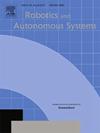半结构化室外环境下清扫机器人全覆盖路径规划策略
IF 5.2
2区 计算机科学
Q1 AUTOMATION & CONTROL SYSTEMS
引用次数: 0
摘要
随着城市环境对自主清洁解决方案的需求不断增加,覆盖路径规划(CPP)技术在清洁机器人领域得到了广泛的发展。清洁机器人必须在复杂的半结构化环境中穿行,这些环境通常具有复杂的区域布局和各种障碍物。本研究提出一种半结构化环境的CPP框架,整合了地图预处理器和覆盖路径规划器。地图预处理器精确处理环境边界和障碍物,优化环境信息,使覆盖路径规划器能够生成更高效的路径。这提高了覆盖效率,使清洁机器人能够适应半结构化的社区环境。仿真和现实世界的实验都表明,所提出的框架比最先进的方法具有显著的性能优势。通过最大化覆盖率和最小化覆盖路径上的匝数,我们的方法显著提高了自主清洁机器人的清洁效率和质量。该研究提高了清洁机器人在半结构化环境中的操作能力,为更广泛的自主路径规划领域提供了有价值的见解和实践指导。本文章由计算机程序翻译,如有差异,请以英文原文为准。
Full coverage path planning strategy for cleaning robots in semi-structured outdoor environments
With the increasing demand for autonomous cleaning solutions in urban environments, Coverage Path Planning (CPP) technology has seen widespread development in the field of cleaning robots. Cleaning robots must navigate complex semi-structured environments, which are often characterized by intricate area layouts and diverse obstacles. This study proposes a CPP framework for semi-structured environments, integrating a map preprocessor and a coverage path planner. The map preprocessor accurately processes environmental boundaries and obstacles, optimizing the environmental information to enable the coverage path planner to generate more efficient paths. This improves coverage efficiency, allowing cleaning robots to adapt to semi-structured community environments. Both simulation and real-world experiments demonstrate that the proposed framework offers significant performance advantages over state-of-the-art methods. By maximizing the coverage rate and minimizing the number of turns in the coverage path, our approach significantly enhances autonomous cleaning robots' cleaning efficiency and quality. This research improves the operational capabilities of cleaning robots in semi-structured environments and provides valuable insights and practical guidance for the broader field of autonomous path planning.
求助全文
通过发布文献求助,成功后即可免费获取论文全文。
去求助
来源期刊

Robotics and Autonomous Systems
工程技术-机器人学
CiteScore
9.00
自引率
7.00%
发文量
164
审稿时长
4.5 months
期刊介绍:
Robotics and Autonomous Systems will carry articles describing fundamental developments in the field of robotics, with special emphasis on autonomous systems. An important goal of this journal is to extend the state of the art in both symbolic and sensory based robot control and learning in the context of autonomous systems.
Robotics and Autonomous Systems will carry articles on the theoretical, computational and experimental aspects of autonomous systems, or modules of such systems.
 求助内容:
求助内容: 应助结果提醒方式:
应助结果提醒方式:


